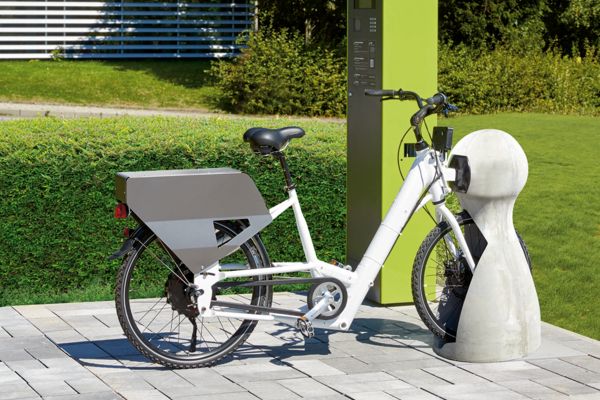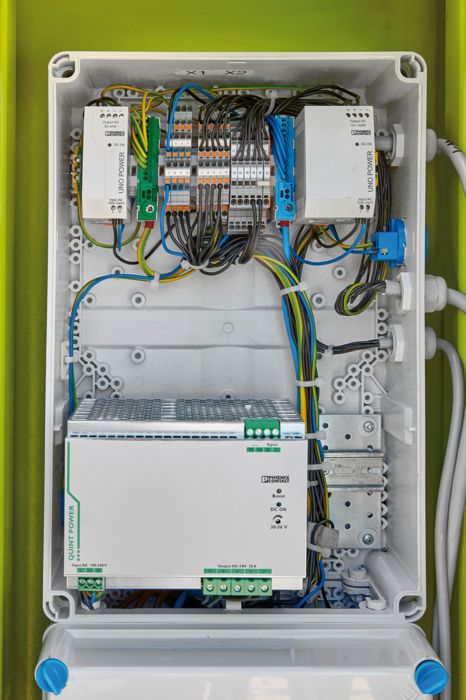Charging stations with a remarkable carbon balance With Pion Technology and Phoenix Contact, Velocity Aachen has developed a charging solution in which a housing system with a special ecological balance is used.

Overview
- The charging infrastructure for e-mobility must not only be extensive and functional, it also needs to satisfy additional ecological criteria.
- With Pion Technology AG, Velocity Aachen GmbH has implemented a solution in which a housing system with a special ecological balance is used in a charging station.
- In addition to numerous components from Phoenix Contact, the raw material concrete is used to filter out fine dust.
- Up to 1,000 e-bikes will soon be available in urban Aachen.
Customer profile
Velocity Aachen GmbH is working with RWTH Aachen University and regional industrial partners to develop a rental-based mobility system for urban infrastructures – Aachen will see intermodal hubs within a charging infrastructure for e-bikes and electric cars. Drivers of electric cars can even switch to e-bikes to continue their journey into the city and avoid traffic.

Power supplies from Phoenix Contact in the control box
Application
Electric vehicles are on trend – they are making a valuable contribution to the energy revolution and environmental protection. It is taking a while to construct the necessary charging infrastructure, however – high investments and long payback periods are discouraging many investors from committing. The lack of full-coverage charging infrastructure has a negative impact on the usability of electric vehicles in everyday situations, and puts off many potential users. The project between Velocity Aachen and Pion Technology AG from Hanau has brought about a possible solution to this dilemma.
Various tariffs, from standard online booking through to annual subscriptions for commuters and frequent travelers, could provide a differentiated range of options for specific target groups. By taking this step, Velocity Aachen is satisfying two success criteria for e-mobility: high availability paired with a sustainable business model. To achieve this, the systems must be carefully maintained and ready for operation at all times.

Concrete charging point for electric cars
Solution
“We have made a promise to keep our customers mobile and we place great importance on high system availability,” explains Dennis Brinckmann, General Manager of Velocity Aachen. “Because energy efficiency is so important to us, all of the technology used must play its part, including the technology provided by our suppliers.”
The innovative housing technology supports Pion Technology AG – with concrete as the housing material for charging stations. Thanks to its photocatalytic properties, it filters fine dust out of the atmosphere.
The stations therefore play an active role in improving the ambient atmosphere. The effect is continuous and does not diminish over time. The fine dust that accumulates on the concrete is washed away from the surface by rain. The Velocity founders rely on another Pion innovation here: ““The self-acclimatizing housing unit used for charging technology guarantees a high degree of process reliability,” says Brinckmann, “as the active cooling elements are not subjected to the high charging power that makes them susceptible to failure.”

CHARX control basic charging controller in accordance with IEC 61851 mode 3
Phoenix Contact is also a charging technology system supplier for Pion. “We were looking for a manufacturer with extensive expertise in e-mobility, so we turned to Phoenix Contact,” recalls Edgar Klug, Managing Director of Pion Technology AG. “Phoenix Contact supports us with both controllers and charging connectors.”
In addition to the solution for e-bikes specially developed for Velocity Aachen, the Hanau-based company also offers mode 3 charging stations for electric cars with the same design. These use CHARX control basic, a compact mode 3 controller from Phoenix Contact based on the IEC 61851 standard. The controller is housed in the charging station base in order to save space. Depending on the design of the charging station – either with an infrastructure charging socket (as per IEC 61851 connection case B) or with a permanently connected cable (connection case C) – a PCB solution specifically optimized for the relevant application is used. Pion uses communication components from Phoenix Contact to integrate the charging stations into cloud-based billing systems.
Summary
Klug won’t reveal the formula for the composition of the concrete, but the costs for sand, cement, and water are significantly lower than for comparable housing concepts made from metal or plastic. Project partners Brinckmann and Klug are excited about the success of their mobility concept, and based on feedback from the market they have every reason to be. The combination of technologies is the key to their success. A sustainable business model, scalable and affordable charging infrastructure, and the ecological balance of the materials used form an interesting overall concept that is helping to increase the attractiveness and acceptance of e-mobility.

